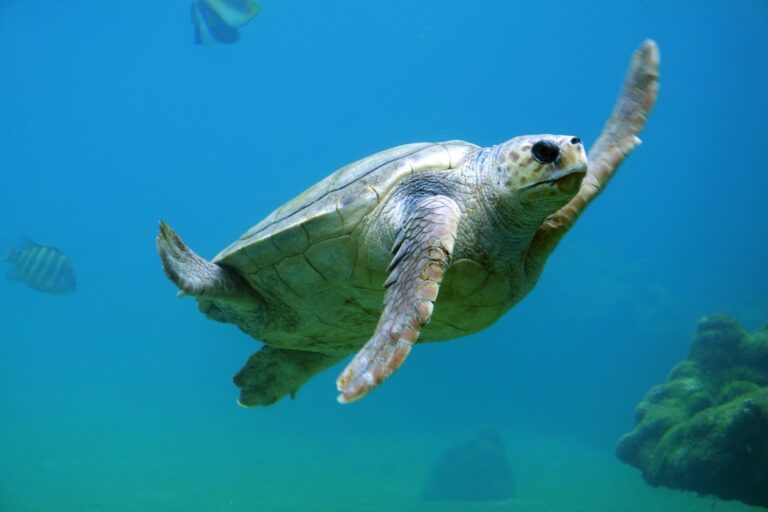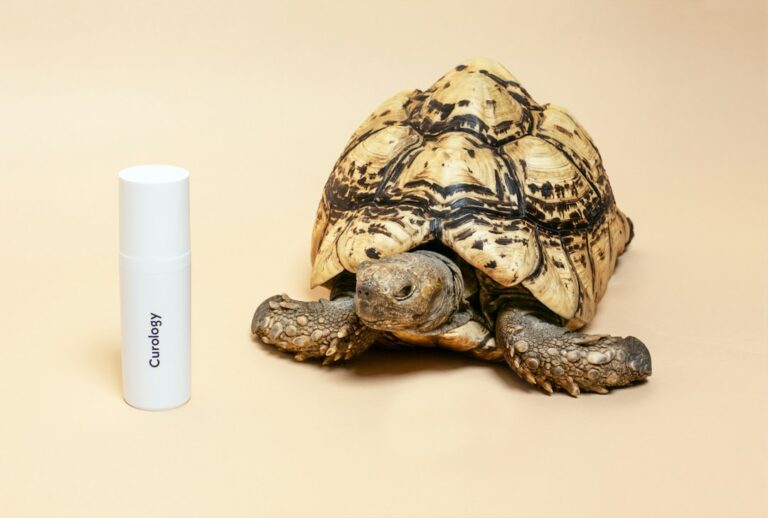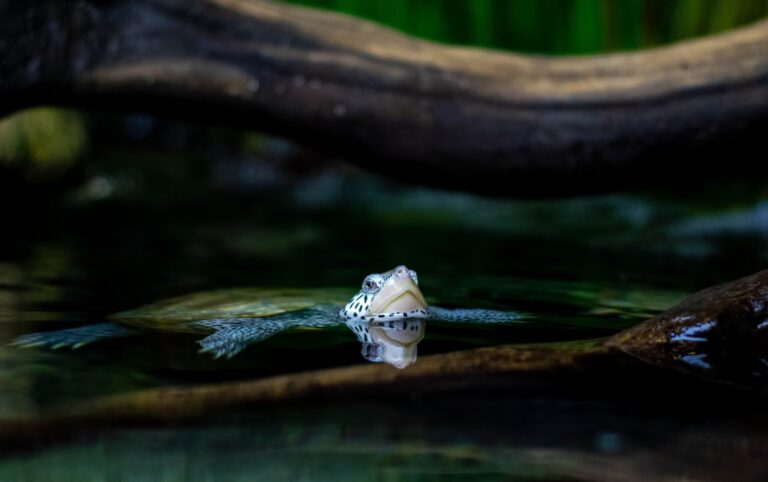Are Turtle Shells Bulletproof?
Turtle shells have long been associated with strength and protection, leading to the question of whether they are truly bulletproof. This article will explore the scientific facts and myths surrounding turtle shell durability and examine their defensive capabilities in nature. By delving into the anatomy of turtle shells and comparing them to modern protective materials, we can determine the truth behind their bulletproof reputation.
Table of Contents
Key Takeaways:
- Turtle shells have a reputation for being bulletproof, but is this myth or reality?
- The anatomy of turtle shells, including their carapace and defense mechanisms, plays a crucial role in their protective capabilities.
- There are common misconceptions about the durability of turtle shells, and it is important to understand their limitations.
- Comparisons between turtle shells and modern protective materials like Kevlar can reveal insights into their strength and resilience.
- Turtle shells have cultural and symbolic significance, and their use in historical artifacts and armor showcases their perceived durability.
The Anatomy of Turtle Shells
The anatomy of turtle shells is crucial to understanding their protective capabilities. The carapace, made up of scutes and a bone structure, provides strength and structural integrity. These scutes and bones are connected through special bonding material, allowing the carapace to resist fractures and withstand external forces.
The Structure and Composition of Turtle Carapaces
The carapace is the hard, protective outer shell that covers the turtle’s back. It is formed from a series of bony plates called scutes, which are composed of keratin, the same material found in human nails. These scutes overlap and interlock with one another, creating a strong and flexible barrier. The arrangement of the scutes differs among different turtle species, influencing the shape and pattern of their shells.
The bone structure within the turtle shell provides additional strength and support. It consists of ribs, vertebrae, and other skeletal elements fused together to form a solid framework. This bone structure adds rigidity and stability to the carapace, making it more resistant to impact.
Overall, the composition and structure of turtle shells make them well-suited for protection against threats in their environment.
Defensive Capabilities of Turtle Shells in Nature
Turtle shells have evolved various defense mechanisms that enhance their protective capabilities. When threatened, turtles can retract their head, tail, and limbs into their shells, offering full-body protection. This ability enables them to fend off predators by creating a nearly impenetrable barrier.
In addition to retracting, turtles can use their shells as shields. They can tuck their head and limbs to expose only the hard shell surface to potential threats. This tactic provides an added layer of defense, as the shell’s tough exterior acts as a barrier against physical attacks.
Moreover, the shape and size of the turtle shell play a role in defense. Some turtle species have convex shells, which offer better protection because they are more difficult for predators to grasp or flip over. This unique adaptation allows turtles to successfully defend themselves and survive in their natural habitats.
Common Misconceptions About Turtle Shell Durability
Despite their reputation for strength and protection, turtle shells are often subject to misconceptions regarding their bulletproof capabilities. One of the most common misconceptions is the belief that turtle shells are completely impenetrable, offering invincible defense against any kind of impact. However, it is important to understand the true nature of turtle shells and dispel these misconceptions.
A common oversight when considering turtle shell durability is that they are not impervious to strong impacts. While turtle shells are indeed sturdy, they have nerves and blood supply, making them vulnerable to injury and pain upon experiencing a forceful blow. This means that turtle shells are not inherently bulletproof, as strong enough projectiles can still penetrate and cause damage.
“Turtle shells are often misunderstood as impenetrable shields, but they have their limitations like any other natural defense mechanism.” – Marine Biologist
By exploring these misconceptions, we can gain a better understanding of the true capabilities and limitations of turtle shells. It is important to differentiate between the strength and durability of turtle shells and the popularized notion of them being bulletproof. This helps to clarify their protective abilities, ensuring accurate information is widely known and preventing the spread of misleading beliefs.
Comparing Turtle Shells to Modern Protective Materials
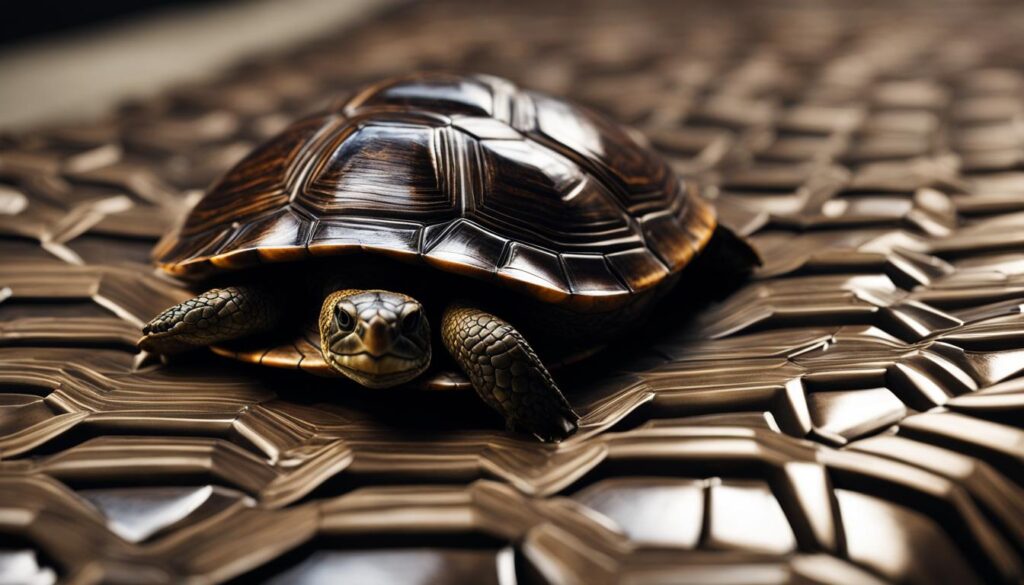
When it comes to determining the durability and protective capabilities of turtle shells, a comparison to modern protective materials is essential. One such material that stands out is Kevlar, renowned for its impressive strength and ability to withstand high impact forces. By examining the properties and performance of turtle shells in contrast to Kevlar and other man-made armor, we can gain valuable insights into their resilience and protective qualities.
How Does a Turtle Shell Match Up Against Kevlar?
Kevlar, a synthetic material developed by DuPont, offers exceptional resistance against penetrating objects and multiples the strength of its users. It is commonly used in various applications, ranging from bulletproof vests to aerospace components. When comparing the durability of turtle shells to Kevlar, it becomes evident that turtle shells possess unique properties that are not present in synthetic materials.
Turtle shells exhibit a combination of flexibility and rigidity, enabling them to absorb and distribute impact forces efficiently. The layered structure of turtle shells, composed of scutes and a bone structure, contributes to their protective capabilities. These scutes and bones are interconnected through specialized bonding material, enabling the shell to resist fractures and withstand external forces to a certain extent.
While Kevlar is highly resistant to penetration, its properties differ from those found in turtle shells. Turtle shells have a unique ability to absorb and disperse impact forces, making them effective at protecting the underlying body. This distinctive feature sets them apart from man-made materials.
Shell Strength Versus Man-Made Armor
When comparing turtle shells to man-made armor, it is important to consider their applications and strengths. Man-made armor, such as metal plates or composite materials, offers exceptional protection against high-velocity projectiles and shrapnel. These materials are meticulously designed and engineered to withstand specific threats encountered in military or industrial settings.
Turtle shells, on the other hand, have evolved naturally over millions of years to provide defense against a wide range of predators. While they may not possess the same level of strength as man-made armor, turtle shells offer a unique combination of durability, flexibility, and weight efficiency that suits their specific needs in nature.
It is important to note that modern protective materials like Kevlar and man-made armor have been designed and optimized for particular applications, surpassing the protective capabilities of turtle shells in specific contexts. However, when considering the overall adaptability and versatility provided by turtle shell structures, they continue to showcase remarkable resilience in their intended environment.
| Comparative Aspect | Turtle Shells | Kevlar | Man-Made Armor |
|---|---|---|---|
| Strength | Remarkable endurance and impact absorption | Exceptional resistance against penetration | Engineered to withstand specific threats |
| Flexibility | Supple yet rigid structure for energy absorption | Flexible and adaptable to different forms | Varies depending on the material composition |
| Weight Efficiency | Relatively lightweight compared to man-made armor | Lightweight, providing agility and mobility | Determined by the specific application and material |
The table above summarizes the comparative aspects of turtle shells, Kevlar, and man-made armor. While turtle shells may not match the specific properties and applications of modern protective materials, their unique structure and characteristics have been fine-tuned through millions of years of evolution to provide effective defense in their natural environment.
Turtles in Culture and Mythology
Turtles hold a significant place in various cultures and mythologies around the world. They are often revered for their symbolism of strength, longevity, and protection. In many ancient cultures, the shell of a turtle is regarded as a powerful symbol of resilience and stability.
The Symbolic Significance of Turtle Shells
The turtle shell has deep symbolic significance in different cultural contexts. It is seen as a representation of protection and defense, guarding against harm and adversity. The intricate patterns and textures on turtle shells are also believed to symbolize growth, wisdom, and the interconnectedness of all living beings.
“The turtle shell serves as a powerful metaphor for our own journey through life. It reminds us to embrace change, adapt to our surroundings, and face challenges with resilience and grace.”
Turtle Shell Use in Historical Artifacts and Armor
Throughout history, turtle shells have been utilized in the creation of various artifacts and pieces of armor. Their perceived durability and protective qualities made them valuable materials for crafting shields, helmets, and body armor. These historical artifacts not only demonstrate the practical uses of turtle shells but also highlight their cultural significance in warfare and defense strategies.
| Artifact | Culture | Symbolism |
|---|---|---|
| Ancient Chinese Turtle Shell Oracle Bones | Ancient China | Used for divination and spiritual communication |
| Haudenosaunee Turtle Clan Masks | Iroquois Confederacy | Represent the sacredness of turtles and their protective qualities |
| Aztec Turtle-Shaped Shields | Aztec Empire | Symbolize the strength and protective capabilities of the turtle |
These historical artifacts not only showcase the ingenuity of cultures but also provide evidence of the long-standing appreciation for turtle shells and their perceived strength.
Are Turtle Shells Bulletproof?
In this section, we will explore the reality of turtle shells against firearms and address the question of whether they are truly bulletproof. By examining scientific evidence and anecdotal reports, we can determine the truth behind the bulletproof reputation of turtle shells and evaluate their resilience in real-life scenarios and pop culture references.
The Reality of Turtle Shells Against Firearms
Turtle shells have long been associated with strength and protection, leading to the belief that they are bulletproof. However, it is important to understand the limitations of turtle shells when it comes to withstanding the force of a bullet. While turtle shells are indeed durable and provide a certain level of protection, they are not impenetrable to firearms.
Scientific evidence suggests that depending on the type of firearm and ammunition used, turtle shells may or may not be able to withstand the impact. Factors such as the distance from which the firearm is fired and the caliber of the bullet play a significant role in determining whether the shell will remain intact or be pierced. It is crucial to remember that turtle shells, while strong, are not designed to provide complete protection against the force and speed of bullets.
Reports of Turtle Shell Resilience in Pop Culture References
Turtle shells have been depicted as remarkably resilient in various pop culture references. From movies and video games to comic books and literature, turtle shells have often been portrayed as impervious shields capable of protecting their owners from harm, including gunfire.
While these portrayals are fictional and exaggerated for the sake of entertainment, they reflect the enduring fascination with the idea of bulletproof turtle shells. Pop culture references often capture the imagination and perpetuate the belief in the invincibility of turtle shells. However, it is important to distinguish between reality and fiction when assessing the actual protective capabilities of turtle shells.
Environmental and Ethical Considerations
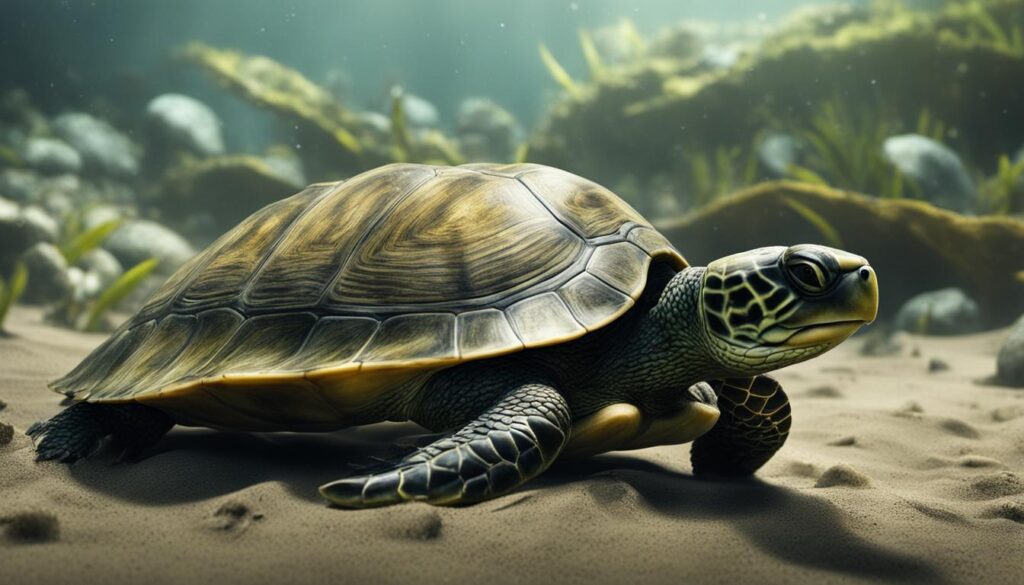
As we explore the durability and protective capabilities of turtle shells, it is crucial to consider the environmental and ethical implications. The illegal trade of turtle shells not only poses a threat to turtle species but also contributes to the overall environmental impact.
The production and sale of turtle shell products often involve the exploitation of turtles for their shells, leading to the decline in turtle populations and disruption of ecosystems. This unethical practice disregards the importance of conserving these magnificent creatures and their habitats.
To address these pressing concerns, conservation efforts play a vital role in protecting turtles and their shells. Initiatives aimed at promoting sustainable practices and responsible use of turtle shell products are crucial steps towards preserving these unique and endangered species.
Conservation organizations work tirelessly to raise awareness about the environmental impact of the turtle shell trade and advocate for the implementation of protective laws. These laws aim to prevent the illegal trade and ensure the conservation of turtles and their habitats.
By understanding the environmental consequences and committing to ethical considerations, we can actively contribute to the protection of turtles and promote sustainable practices that safeguard their future and conserve their shells for generations to come.
“The illegal trade of turtle shells not only poses a threat to turtle species but also contributes to the overall environmental impact.”
Conservation Status of Turtles and Protective Laws
Turtles are facing numerous threats to their survival, including habitat loss and the illegal trade of their shells. It is crucial to understand the conservation status of turtles, the protective laws in place, and the detrimental impact of the shell trade on various turtle species. By addressing these issues, we can work towards protecting turtles and their valuable shells.
The Illegal Trade of Turtle Shells and Its Impact on Species
The illegal trade of turtle shells is a significant concern for the conservation of turtle populations. The demand for turtle shells, driven by their use in various traditional practices and the exotic pet trade, has led to the exploitation and decline of several turtle species. This illegal trade threatens the survival of many turtle species, pushing them closer to extinction.
To combat the illegal trade, countries around the world have implemented protective measures and legislation. These laws aim to regulate and restrict the trade of turtle shells, making it illegal to exploit and sell them. By imposing penalties and strengthening enforcement efforts, governments are taking steps to deter and combat the illegal trade, ultimately protecting turtle populations.
Protecting Turtle Habitats and Their Shells
Habitat protection plays a crucial role in conserving turtle populations and their shells. Turtles rely on specific habitats, such as nesting beaches for sea turtles or freshwater ecosystems for freshwater turtles, for feeding, reproduction, and survival. By preserving and restoring these habitats, we can provide turtles with the necessary resources and conditions to thrive.
In addition to habitat protection, it is essential to promote responsible and sustainable practices regarding turtle shells. This includes discouraging the sale and purchase of turtle shell products and raising awareness about the negative impact of the trade on turtle populations. By promoting alternatives and educating communities, we can reduce the demand for turtle shells and contribute to their conservation.
| Turtle Species | Conservation Status |
|---|---|
| Green Turtle | Endangered |
| Loggerhead Turtle | Endangered |
| Hawksbill Turtle | Critically Endangered |
| Leatherback Turtle | Vulnerable |
The table above highlights the conservation status of some turtle species. These designations reflect the level of threat they face and the urgency to conserve them. It is important for individuals, communities, and governments to contribute to the conservation efforts aimed at protecting these species and their shells.
Advancements in Synthetic Armor Inspired by Nature
Nature has always been a source of inspiration for scientists and engineers in their quest to develop new and innovative technologies. One area where nature has played a significant role is in the development of synthetic armor. By studying the natural world and the remarkable structures found within it, researchers have been able to create futuristic materials that mimic the strength and durability of naturally occurring substances.
Biomimicry: Learning from Turtle Shell Structure
One example of biomimicry, the practice of mimicking biological systems, is the study of turtle shell structure. The unique composition and design of a turtle’s shell provide exceptional protection against external threats. The carapace, made up of numerous scutes, is constructed in a way that distributes and absorbs impact forces, similar to a synthetic armor.
Scientists have closely examined the microarchitecture of turtle shells, analyzing the arrangement of the scutes and the bonding material that holds them together. By understanding these structural principles, researchers have been able to design synthetic armor that incorporates similar features, such as layered materials and interlocking structures, to enhance strength and resilience.
Futuristic Materials Taking Cues from Turtle Biology
Furthermore, advancements in material science have allowed for the creation of futuristic materials that draw inspiration from turtle biology. These materials combine innovative engineering techniques with synthetic compounds to replicate the properties of turtle shells. By utilizing cutting-edge manufacturing processes, researchers have been able to develop lightweight yet robust materials that offer enhanced protection without sacrificing mobility.
These futuristic materials are not only being used in the development of advanced protective gear for military and law enforcement personnel but also find applications in other industries such as aerospace, automotive, and sports equipment. The incorporation of turtle shell-inspired design principles in synthetic armor has opened up new possibilities for creating protective solutions that are both highly effective and environmentally sustainable.
As scientists continue to unravel the secrets of turtle biology and the remarkable properties of their shells, it is evident that nature’s designs hold great potential for solving human challenges. By combining the principles of biomimicry with advancements in material science, the development of synthetic armor inspired by turtle shells has paved the way for the creation of innovative protection solutions that push the boundaries of what is possible.
Conclusion
Debunking the Myth of Turtle Shell Invulnerability:
After a thorough examination of the question, it has been determined that turtle shells are not bulletproof. The belief in their invulnerability is a myth that has permeated popular culture. While turtle shells are undoubtedly strong and durable, they have their limitations.
The Intriguing Blend of Fiction and Turtle Shell Facts:
However, this myth has led to an intriguing blend of fiction and factual information surrounding turtle shells. Throughout history, turtles and their shells have been symbolic of resilience and protection. They have inspired awe and admiration, leading to their incorporation in historical artifacts and armor.
By dispelling misconceptions and presenting scientific evidence, we gain a clearer understanding of the true nature of turtle shells. They may not be bulletproof, but their strength and protective capabilities should still be appreciated and respected.
FAQ
Are turtle shells bulletproof?
No, turtle shells are not completely bulletproof. While they offer protection against some predators, a strong enough impact can cause injury and pain to the turtle.
What is the anatomy of a turtle shell?
A turtle shell is composed of scutes and a bone structure called a carapace. These scutes and bones are connected through a special bonding material, providing strength and resistance to fractures.
Do turtle shells have defensive capabilities in nature?
Yes, turtles have evolved various defense mechanisms. They can retract their head and limbs into their shells, using their shells as shields against predators.
Are turtle shells completely bulletproof?
No, turtle shells are not invulnerable to bullets. Although they are strong and provide protection, a bullet can still penetrate the shell if it hits with enough force.
How do turtle shells compare to modern protective materials like Kevlar?
Turtle shells offer durability and resilience, but they are not as strong as man-made materials like Kevlar. Kevlar, known for its high impact resistance, surpasses the protective capabilities of turtle shells.
What is the significance of turtle shells in culture and mythology?
Turtle shells have symbolized strength, longevity, and protection in various cultures. They have been used in the creation of historical artifacts and armor, showcasing their perceived durability.
Can a turtle shell withstand the force of a bullet?
While turtle shells are strong, they are not completely bulletproof. The force of a bullet can fracture or penetrate the shell, potentially causing harm to the turtle.
What are the environmental and ethical implications of turtle shell products?
The illegal trade of turtle shells and the impact on turtle species are significant concerns. Protecting turtle habitats and responsible use of turtle shell products are crucial for conservation efforts.
What is the conservation status of turtles and the protective laws in place?
Turtles face various threats, including habitat loss and the illegal trade of their shells. Protective laws aim to safeguard turtle populations and mitigate the harmful effects of the shell trade.
How have scientists and engineers drawn inspiration from turtle shells for synthetic armor?
Scientists have taken inspiration from turtle shell structures to develop synthetic armor. Through biomimicry, futuristic materials can replicate the strength and durability of turtle shells.


